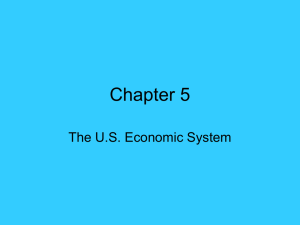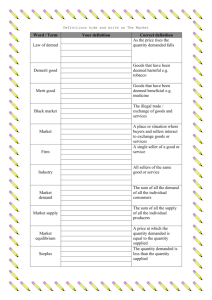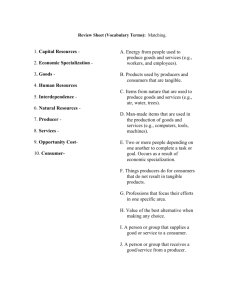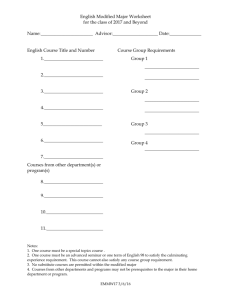Specific Objectives
advertisement
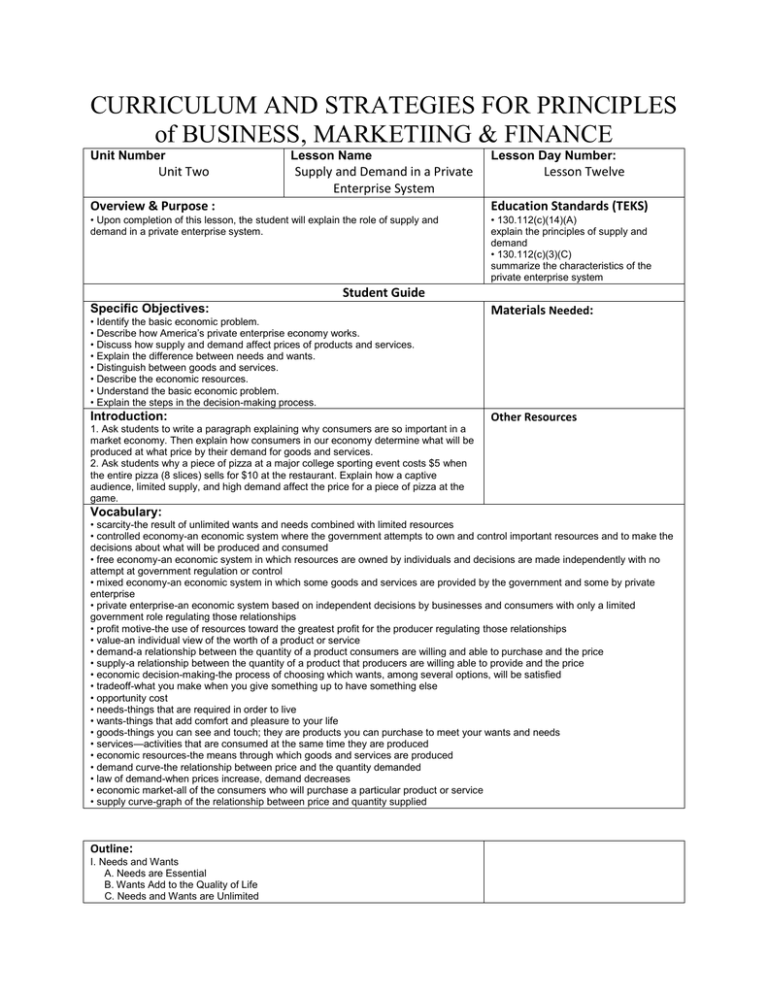
CURRICULUM AND STRATEGIES FOR PRINCIPLES of BUSINESS, MARKETIING & FINANCE Unit Number Unit Two Lesson Name Supply and Demand in a Private Enterprise System Lesson Day Number: Lesson Twelve Overview & Purpose : Education Standards (TEKS) • Upon completion of this lesson, the student will explain the role of supply and demand in a private enterprise system. • 130.112(c)(14)(A) explain the principles of supply and demand • 130.112(c)(3)(C) summarize the characteristics of the private enterprise system Student Guide Specific Objectives: • Identify the basic economic problem. • Describe how America’s private enterprise economy works. • Discuss how supply and demand affect prices of products and services. • Explain the difference between needs and wants. • Distinguish between goods and services. • Describe the economic resources. • Understand the basic economic problem. • Explain the steps in the decision-making process. Introduction: Materials Needed: Other Resources 1. Ask students to write a paragraph explaining why consumers are so important in a market economy. Then explain how consumers in our economy determine what will be produced at what price by their demand for goods and services. 2. Ask students why a piece of pizza at a major college sporting event costs $5 when the entire pizza (8 slices) sells for $10 at the restaurant. Explain how a captive audience, limited supply, and high demand affect the price for a piece of pizza at the game. Vocabulary: • scarcity-the result of unlimited wants and needs combined with limited resources • controlled economy-an economic system where the government attempts to own and control important resources and to make the decisions about what will be produced and consumed • free economy-an economic system in which resources are owned by individuals and decisions are made independently with no attempt at government regulation or control • mixed economy-an economic system in which some goods and services are provided by the government and some by private enterprise • private enterprise-an economic system based on independent decisions by businesses and consumers with only a limited government role regulating those relationships • profit motive-the use of resources toward the greatest profit for the producer regulating those relationships • value-an individual view of the worth of a product or service • demand-a relationship between the quantity of a product consumers are willing and able to purchase and the price • supply-a relationship between the quantity of a product that producers are willing able to provide and the price • economic decision-making-the process of choosing which wants, among several options, will be satisfied • tradeoff-what you make when you give something up to have something else • opportunity cost • needs-things that are required in order to live • wants-things that add comfort and pleasure to your life • goods-things you can see and touch; they are products you can purchase to meet your wants and needs • services—activities that are consumed at the same time they are produced • economic resources-the means through which goods and services are produced • demand curve-the relationship between price and the quantity demanded • law of demand-when prices increase, demand decreases • economic market-all of the consumers who will purchase a particular product or service • supply curve-graph of the relationship between price and quantity supplied Outline: I. Needs and Wants A. Needs are Essential B. Wants Add to the Quality of Life C. Needs and Wants are Unlimited D. Goods and service E. Goods and Services for Businesses and Consumers 1. businesses need steel, plastic, gasoline, computers, and a constant supply of electricity, security for buildings and equipment, and accountants to maintain records and file tax returns 2. consumers buy watches, televisions, cell phones, and books 3. consumers go on vacations and take their car to the dealership for service F. U.S. Economy 1. largest producer of goods and services in the world 2. Americans consume more than any other country 3. America has twice as many shopping malls as it does high schools 4. Americans use credit to buy now and pay later 5. high level of demand may stem from the quantity of goods and services available and the amount of money businesses spend to advertise II. Economic Resources-means through which goods and services are produced (factors of production) A. natural resources-raw materials B. human resources-people who produce goods and services C. Capital Resources-tools and equipment D. Resources are Limited III. The Basic Economic Problem A. Scarcity-not having enough resources to satisfy every need B. choices-made based on scarcity C. economic decision-making-process of choosing which wants, among several options, will be satisfied D. trade-off-when you give up something to have something else E. opportunity cost-the value of the next-best alternative that you did not choose IV. Who Makes the Decisions? A. Questions Economies Must Answer 1. What goods and services will be produced? 2. How will the goods and services be produced? 3. For whom will the goods and services be produced? B. Different Economies 1. Controlled economy-government answers the three economic questions and attempts to own and control important resources 2. Free economy (market economy) resources are owned by individuals rather than the government and the market provides answers to the three economic questions with no attempt at government regulation or control 3. Mixed economy-some goods and services are provided by the government and some by private enterprise V. America’s Private Enterprise Economy A. Based upon independent decisions by businesses and consumers with only a limited government role regulating those relationships B. Characteristics of the Private Enterprise Economy 1. profit motive-use of resources to obtain the greatest profit 2. resources of production are owned and controlled by individual producers 3. individual consumers make decisions about what will be purchased to satisfy needs 4. consumers use value in deciding what to consume-individual view of the worth of a product or service 5. the government stays out of exchange activities between producers and consumers unless it is clear that individuals or society are harmed by the decisions 6. consumers-individuals who purchase products and services to satisfy needs 7. demand-a relationship between the quantity of a product consumers are willing and able to purchase and the price 8. producers-businesses that use their resources to develop products and services 9. supply-a relationship between the quantity of a product that producers are willing and able to provide and the price 10. government-allows consumers and producers to make decisions without any interference VI. Microeconomics and Consumer Demand A. Macroeconomics-studies the economic behavior and relationships of an entire society B. Microeconomics examines relationships between individual consumers and producers C. Factors Affecting Demand 1. strength of the need or want 2. available supply of products and services to satisfy needs 3. availability of alternative products that consumers believe will satisfy their Ask students to make a list of their current needs and a list of their current wants. Do they have enough financial resources to meet all of their needs and wants? Explain how individuals make choices about how to spend limited resources. With a greater number of shopping malls competing for consumer dollars, prices go down. Popular events with limited capacity and highly-demanded limited edition products will demand high prices. The economy is similar to an auction where several bidders are competing to buy the same product, causing the price to go up. Every economy has limited resources. Important decisions must be made about how to use the limited resources The government is no different than individuals. We demand more than we can afford. Decisions that involve tradeoffs and opportunity costs will determine how limited resources are spent. Each type of economy has a different plan for answering economic questions. Consumers are powerful in the market economy. Mixed economies involve private enterprise with some government involvement. Money provides the incentive for individuals to work. The profit motive gives businesses the incentive to exist. The amount of product or service supplied, depends upon consumer demand. Producers will use resources to make the products demanded by consumers. Economics revolve around the law of supply and demand. Prices have a definite impact on the amount supplied or demanded. Profit is the incentive for businesses and entrepreneurs to produce products that they hope will sell. Profit also brings more competition to the marketplace. Competition is good for consumers because it offers more choices. Competition causes businesses to be more efficient, lowers prices, and improves the quality of products. needs 4. Demand Curves a. the relationship between price and the quantity demanded b. rising prices result in lower demand 5. Economic Market-all of the consumers who will purchase a particular product or service D. Supplying the Product 1. possibility of profit 2. amount of competition 3. capability of developing and marketing products or services 4. economic resources 5. Supply Curve a. graph of the relationship between price and quantity supplied b. Law of Supply-when price of a product goes down, fewer products will be produced E. Market Price-point where supply and demand for a product are equal IV. The Decision-Making Process A. Define the problem. B. Identify the choices. C. Evaluate the advantages and disadvantages of each choice. D. Choose one choice. E. Act on your choice. F. Review your decision. Looking Forward: Q: What are two things that are unlimited for consumers? A: Needs and wants are unlimited for consumers. Q: Which economy is the largest producer of goods and services in the world? A: The U.S. economy is the largest producer of goods and services in the world. Q: How does consumption in America compare to the rest of the world? A: Americans consume more than any other country. Q: What are three categories of economic resources? A: Three categories of economic resources include natural, human, and capital. Q: What is the basic economic problem? A: The basic economic problem is scarcity. Q: What is a tradeoff? A: Tradeoff is when you give up something to have something else. Q: What is an opportunity cost? A: Opportunity cost is the value of the next-best alternative that you did not choose. Q: What are three questions each economy must answer? A: Three questions include what goods and services will be produced, how will the goods and services be produced, and for whom will the goods and services be produced. Q: Which type of economy has the government answering the three economic questions? A: The controlled economy allows the government to answer all three economic questions. Q: What is a driving force in the private enterprise economy? A: The driving force in the private enterprise economy is the profit motive. Q: What factors affect the demand for a product: A: Factors that affect demand include strength of the need or want, available supply of products and services to satisfy needs, and available alternative products that consumers believe will satisfy their needs. Q: What is an economic market? A: Economic market is all of the consumers who will purchase a particular product or service. Q: What happens to the supply when the price for a product goes down? A: When the price goes down, a smaller amount of the product will be supplied. Individuals and businesses use the decision-making process. Businesses use the process to determine what to produce to meet consumer needs. Individuals use the process to determine the most important needs and wants to purchase. ECONOMIC RESOURCES Ask students to list the three types of economic resources. Then students must choose a product and describe how each economic resource is needed and used in its production. Write a paragraph to explain the economic resources for your chosen product.

